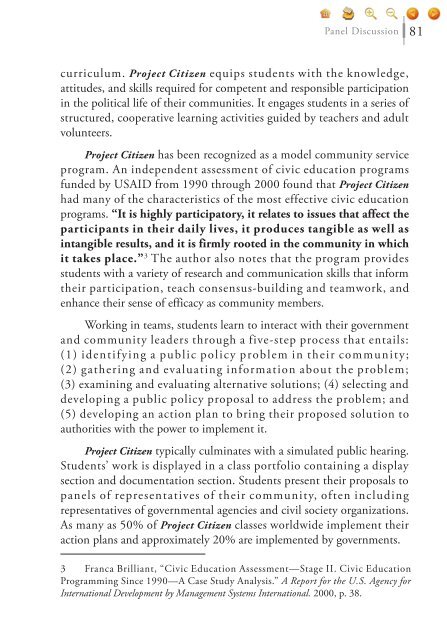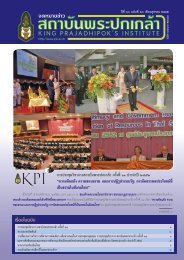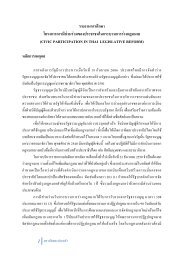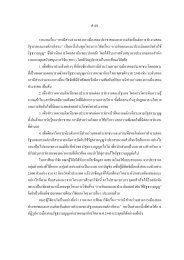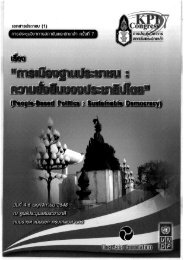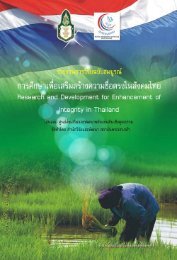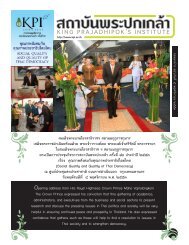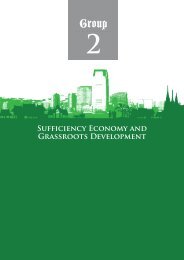Conflict, Legitimacy and Government Reform: Equitable Allocation of ...
Conflict, Legitimacy and Government Reform: Equitable Allocation of ...
Conflict, Legitimacy and Government Reform: Equitable Allocation of ...
You also want an ePaper? Increase the reach of your titles
YUMPU automatically turns print PDFs into web optimized ePapers that Google loves.
Panel Discussion<br />
curriculum. Project Citizen equips students with the knowledge,<br />
attitudes, <strong>and</strong> skills required for competent <strong>and</strong> responsible participation<br />
in the political life <strong>of</strong> their communities. It engages students in a series <strong>of</strong><br />
structured, cooperative learning activities guided by teachers <strong>and</strong> adult<br />
volunteers.<br />
Project Citizen has been recognized as a model community service<br />
program. An independent assessment <strong>of</strong> civic education programs<br />
funded by USAID from 1990 through 2000 found that Project Citizen<br />
had many <strong>of</strong> the characteristics <strong>of</strong> the most effective civic education<br />
programs. “It is highly participatory, it relates to issues that affect the<br />
participants in their daily lives, it produces tangible as well as<br />
intangible results, <strong>and</strong> it is firmly rooted in the community in which<br />
it takes place.” 3 The author also notes that the program provides<br />
students with a variety <strong>of</strong> research <strong>and</strong> communication skills that inform<br />
their participation, teach consensus-building <strong>and</strong> teamwork, <strong>and</strong><br />
enhance their sense <strong>of</strong> efficacy as community members.<br />
Working in teams, students learn to interact with their government<br />
<strong>and</strong> community leaders through a five-step process that entails:<br />
(1) identifying a public policy problem in their community;<br />
(2) gathering <strong>and</strong> evaluating information about the problem;<br />
(3) examining <strong>and</strong> evaluating alternative solutions; (4) selecting <strong>and</strong><br />
developing a public policy proposal to address the problem; <strong>and</strong><br />
(5) developing an action plan to bring their proposed solution to<br />
authorities with the power to implement it.<br />
Project Citizen typically culminates with a simulated public hearing.<br />
Students’ work is displayed in a class portfolio containing a display<br />
section <strong>and</strong> documentation section. Students present their proposals to<br />
panels <strong>of</strong> representatives <strong>of</strong> their community, <strong>of</strong>ten including<br />
representatives <strong>of</strong> governmental agencies <strong>and</strong> civil society organizations.<br />
As many as 50% <strong>of</strong> Project Citizen classes worldwide implement their<br />
action plans <strong>and</strong> approximately 20% are implemented by governments.<br />
3 Franca Brilliant, “Civic Education Assessment—Stage II. Civic Education<br />
Programming Since 1990—A Case Study Analysis.” A Report for the U.S. Agency for<br />
International Development by Management Systems International. 2000, p. 38.<br />
81


